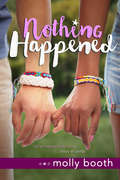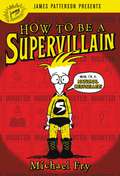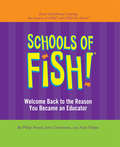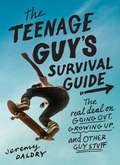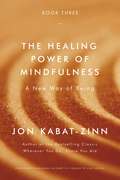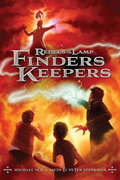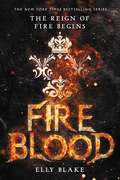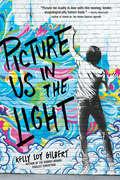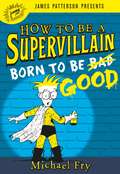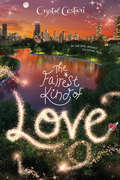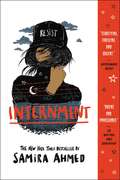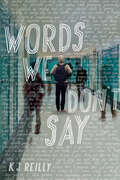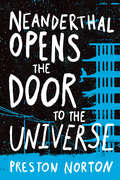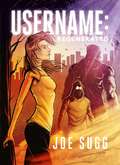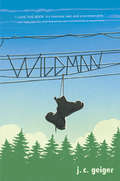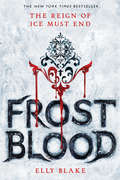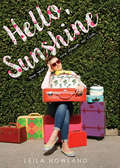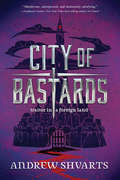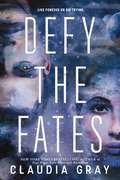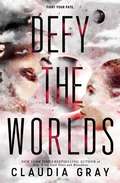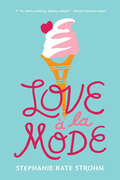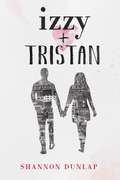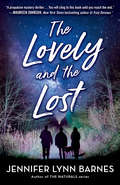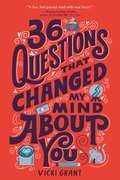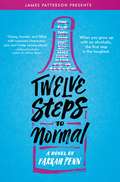- Table View
- List View
Nothing Happened
by Molly BoothIT'S MUCH ADO . . . ABOUT EVERYTHING.This modern-day retelling of Shakespeare's Much Ado About Nothing takes place at the idyllic Camp Dogberry, where sisters Bee and Hana Leonato have lived their whole lives. Their parents own the place, and every summer they look forward to leading little campers in crafts, swimming in the lake, playing capture the flag and Sproutball, and of course, throwing legendary counselor parties.This year, the camp drama isn't just on the improv stage. Bee and longtime counselor Ben have a will-they-or-won't-they romance that's complicated by events that happened-or didn't happen-last summer. Meanwhile, Hana is falling hard for the kind but insecure Claudia, putting them both in the crosshairs of resident troublemaker John, who spreads a vicious rumor that could tear them apart.As the counselors juggle their camp responsibilities with simmering drama that comes to a head at the Fourth of July sparkler party, they'll have to swallow their pride and find the courage to untangle the truth, whether it leads to heartbreak or happily ever after.
How to Be a Supervillain (How to Be a Supervillain #1)
by James Patterson Michael FryVictor Spoil comes from a long line of famous supervillains and he's fully expected to join their ranks one day. But to his family's utter disappointment, Victor doesn't have a single bad-guy bone in his body. He won't run with scissors, he always finishes his peas, and he can't stand to be messy. Hopeless!As a last-ditch effort before they give up and let him be a--gasp!--civilian, Victor's exasperated parents send him to apprentice under a disgraced supervillain called The Smear. This matchup starts off as a complete disaster, but Victor and The Smear eventually find that they have a lot to learn from each other. When the stakes get high as Victor is forced to choose between his mentor and his family morals (or lack thereof)...what will the world's nicest bad guy do?In this rollicking middle-grade adventure, Michael Fry's witty text and hysterical artwork combines superhero action with classic fish-out-of-water humor.
Schools of Fish!
by John Christensen Philip Strand Andy HalperIt's two minutes to 8:00. Time to put on your tights and cape. As an educator, every time that bell rings, you face dozens of challenges. Students with overwhelming personal and academic needs. Creativity-stifling mandates. Administrivia. Cynicism. Apathy. The things that keep you from being the educator you want to be. The FISH! Philosophy--four simple principles: Be There, Play, Make Their Day, and Choose Your Attitude--has helped educators around the world build more effective, fulfilling relationships that lead to better learning. It is also backed by tons (OK, about a hundred pounds) of research on classroom management. Schools of FISH! is full of inspiring and instructive stories about people just like you--with hopes and challenges just like yours. It's about real-life heroes who give the best in themselves to help their students find the best in themselves. Schools of FISH! offers practical ideas on classroom management. It addresses the issues you deal with every day--improving learning, respect and personal accountability, self-discipline and internal motivation, and finding ways to make learning more fun. Because you're not just teaching students to learn . . . you're inspiring them to want to learn.
The Teenage Guy's Survival Guide: The Real Deal on Going Out, Growing Up, and Other Guy Stuff
by Jeremy DaldryThe go-to book about growing up for teenage (or soon-to-be teenage) boys everywhere, updated with brand-new content for today's social media-driven world. Why do crushes make a person go crazy?Where is the best place to break up?What's up with bad teenage mustaches?With chapters covering everything from dating, kissing, and shaving, to moods, peer pressure, bullying, and drugs, The Teenage Guy's Survival Guide offers the real deal on everything guys want to know. Author Jeremy Daldry tackles the various issues adolescent boys face with irreverence and true understanding - and without giving them a nervous breakdown.This revised second edition has been updated to address all sexualities, to reflect changes in the way kids hang out and party, and to tackle the myriad of other challenges brought on by today's social media-driven world. Like nothing else in the market, The Teenage Guy's Survival Guide gives kids the advice they need from someone who feels like a big brother.
The Healing Power of Mindfulness: A New Way of Being
by Jon Kabat-ZinnDiscover how mindfulness can help you with healing.More than twenty years ago, Jon Kabat-Zinn showed us the value of cultivating greater awareness in everyday life with his now-classic introduction to mindfulness, Wherever You Go, There You Are. Now, in The Healing Power of Mindfulness, he shares a cornucopia of specific examples as to how the cultivation of mindfulness can reshape your relationship with your own body and mind--explaining what we're learning about neuroplasticity and the brain, how meditation can affect our biology and our health, and what mindfulness can teach us about coming to terms with all sorts of life challenges, including our own mortality, so we can make the most of the moments that we have. Originally published in 2005 as part of a larger book titled Coming to Our Senses, The Healing Power of Mindfulness features a new foreword by the author and timely updates throughout the text. If you are interested in learning more about how mindfulness as a way of being can help us to heal, physically and emotionally, look no further than this deeply personal and also "deeply optimistic book, grounded in good science and filled with practical recommendations for moving in the right direction" (Andrew Weil, MD), from one of the pioneers of the worldwide mindfulness movement.
Finders Keepers (Rebels of the Lamp #2)
by Peter Speakman Michael GalvinAfter Parker and his friends destroyed the evil genie, Xaru, they awoke an even greater threat: Vesiroth. An immortal sorcerer who was frozen for centuries is now free, and he's determined to finish what he had started-taking over the world. In order to accomplish his goal he must find the Elicuum Helm, an ancient object that will grant the user extraordinary powers. But the helm was broken into three pieces many years ago, and now Parker, along with his genie, Fon-Rham, his cousin Theo, Reese and Vesiroth's former protégé, will have to travel the globe to find the helm first before it's too late.
Fireblood (The Frostblood Saga #2)
by Elly BlakeIn this action-packed sequel to the New York Times bestselling Frostblood, Ruby must choose between her fiery homeland and the icy king who loves her.Against all odds, Ruby has defeated the villainous Frost King and melted his powerful throne. But the bloodthirsty Minax that was trapped inside is now haunting her kingdom and everyone she loves. The answers to its demise may lie to the south in Sudesia, the land of the Firebloods, and a country that holds the secrets to Ruby's powers and past....Despite warnings from her beloved Arcus, Ruby accompanies a roguish Fireblood named Kai to Sudesia, where she must master her control of fire in a series of trials to gain the trust of the suspicious Fireblood queen. Only then can she hope to access the knowledge that could defeat the rampaging Minax--which grows closer every moment. But as sparks fly in her moments alone with Kai, how can Ruby decide whom to trust? The fate of both kingdoms is now in her hands.
Picture Us In The Light
by Kelly Loy Gilbert"Picture me madly in love with this moving, tender, unapologetically honest book."-Becky Albertalli, #1 best-selling author of Simon Vs. the Homo Sapiens Agenda Winner of the California Book Award and Stonewall Honor! Danny Cheng has always known his parents have secrets. But when he discovers a taped-up box in his father's closet filled with old letters and a file on a powerful Bay Area family, he realizes there's much more to his family's past than he ever imagined.Danny has been an artist for as long as he can remember and it seems his path is set, with a scholarship to RISD and his family's blessing to pursue the career he's always dreamed of. Still, contemplating a future without his best friend, Harry Wong, by his side makes Danny feel a panic he can barely put into words. Harry's and Danny's lives are deeply intertwined and as they approach the one-year anniversary of a tragedy that shook their friend group to its core, Danny can't stop asking himself if Harry is truly in love with his girlfriend, Regina Chan.When Danny digs deeper into his parents' past, he uncovers a secret that disturbs the foundations of his family history and the carefully constructed façade his parents have maintained begins to crumble. With everything he loves in danger of being stripped away, Danny must face the ghosts of the past in order to build a future that belongs to him.
How to Be a Supervillain: Born to Be Good (How to Be a Supervillain #2)
by Michael FryA sequel has never been this good...at being bad! In this highly anticipated follow-up to the bestselling How to Be a Supervillain, Victor Spoil must save the world from an evil scheme to enslave the superheroes and villains--to his parents' utter disappointment.Victor Spoil hates the Junior Super Academy. It makes him cranky--and his parents couldn't be prouder, because supervillains aren't meant to be nice. Until Victor confesses he wants to leave and become a librarian. The horror!But when superheroes and villains--including his parents--start disappearing, only a dedicated do-gooder like Victor can track them down. He discovers that the supers are being captured to square off against aliens in gladiator-like shows. And unlike the scripted fights that the supers usually sign up for, these battles are to the death!Victor and his fellow super students must join together and harness their super powers to battle this dastardly mega-villain. But to be a hero, Victor finally has to embrace his inner villain. Will he be able to stoop that low?
The Fairest Kind of Love (Windy City Magic #3)
by Crystal Cestari"Amber! I never even thought of that! Maybe she can tell you your match."Whoa. Now that's interesting.Amber Sand has spent half her life solidifying other people's happily-ever-afters. As a matchmaker, she has the ability to look into anyone's eyes and see their perfect match. But lately, her powers have been on the fritz, and not only is she totally unsure whether her matches are true, she can't see anyone in the eyes of her boyfriend Charlie Blitzman. With Amber and her friends graduating high school and about to take off for various colleges, Amber is hoping to have one last carefree summer-but she's also dying to find a way to fix her powers, and learn, for better or worse, if she and Charlie are truly meant to be.So when an online matchmaker named Madame Lamour comes to Chicago, Amber sets out to talk to her and find out who her match is once and for all. Of course, when it comes to the magical community, nothing's ever that easy, and Amber soon finds herself caught up in a breathless showdown that involves a fairy family feud and a magical-creature auction--and requires teaming up with a certain siren nemesis. Can Amber and her friends save the day one more time before setting off for their new lives? And will Amber ever learn whether Charlie is her one true love?With tons of laugh-out-loud moments, appearances by all your favorite characters, and one totally tearful reveal, you won't want to miss a single swoony moment of this romantic conclusion to the Windy City Magic trilogy.
Internment
by Samira AhmedRebellions are built on hope. <P><P>Set in a horrifying near-future United States, seventeen-year-old Layla Amin and her parents are forced into an internment camp for Muslim American citizens. <P><P>With the help of newly made friends also trapped within the internment camp, her boyfriend on the outside, and an unexpected alliance, Layla begins a journey to fight for freedom, leading a revolution against the internment camp's Director and his guards. <P><P>Heart-racing and emotional, Internment challenges readers to fight complicit silence that exists in our society today. <P><b>A New York Times Bestseller</b>
Words We Don't Say
by K. J. ReillyJoel Higgins has 901 unsent text messages saved on his phone. Ever since the thing that happened, there are certain people he hasn't been able to talk to in person. Sure, he shows up at school, does his mandatory volunteer hours at the soup kitchen, and spends pretty much every moment thinking about Eli, the most amazing girl in the world. But that doesn't mean he's keeping it together, or even that he has any friends. So instead of hanging out with people in real life, he drafts text messages. But he never presses send. As dismal as sophomore year was for Joel, he doesn't see how junior year will be any better. For starters, Eli doesn't know how he feels about her, his best friend Andy's gone, and he basically bombed the SATs. But as Joel spends more time at the soup kitchen with Eli and Benj, the new kid whose mouth seems to be unconnected to his brain, he forms bonds with the people they serve there-including a veteran they call Rooster-and begins to understand that the world is bigger than his own pain. In this dazzling, hilarious, and heartbreaking debut, Joel grapples with the aftermath of a tragic loss as he tries to make sense of the problems he's sees all around him with the help of banned books, Winnie-the-Pooh, a field of asparagus, and many pairs of socks.
Neanderthal Opens the Door to the Universe
by Preston NortonPerfect for fans of John Green and Becky Albertalli, Neanderthal Opens the Door to the Universe is a "sneakily thought-provoking" and "utterly unforgettable" must-read for every fan of contemporary YA. Cliff Hubbard is a huge loser. Literally. His nickname at Happy Valley High School is Neanderthal because he's so enormous-6'6" and 250 pounds to be exact. He has nobody at school, and life in his trailer-park home has gone from bad to worse ever since his older brother's suicide. There's no one Cliff hates more than the nauseatingly cool quarterback Aaron Zimmerman. Then Aaron returns to school after a near-death experience with a bizarre claim: while he was unconscious he saw God, who gave him a list of things to do to make Happy Valley High suck less. And God said there's only one person who can help: Neanderthal. To his own surprise, Cliff says he's in. As he and Aaron make their way through the List, which involves a vindictive English teacher, a mysterious computer hacker, a decidedly unchristian cult of Jesus Teens, the local drug dealers, and the meanest bully at HVHS, Cliff feels like he's part of something for the first time since losing his brother. But fixing a broken school isn't as simple as it seems, and just when Cliff thinks they've completed the List, he realizes their mission hits closer to home than he ever imagined. Razor sharp, moving, and outrageously funny, Neanderthal Opens the Door to the Universe is an unforgettable story of finding your place in an imperfect world.
Username: Regenerated
by Joe SuggThe second book by YouTube star Joe Sugg, Username: Regenerated picks up after the events of Username: Evie. In it, Evie is coming to terms with e.scape's reboot and the loss of avatar Lionel. She is desperate to gain access to the virtual reality again and pretends to have feelings for real-world Lionel so he'll fix the program. When he discovers that she's using him, real-world Lionel deletes e.scape in a fit of anger. Immediately regretting what he's done, he finds an older version, reboots it, and inadvertently brings an earlier virtual reality back to life. Meanwhile, in the e.scape, avatar Lionel befriends one of the brutes. After the reboot, the brute finds a computer that allows him to escape to the real world. Once he's gone, avatar Lionel quickly discovers what happened and goes after his friend. The two stories become intertwined with old friends reunited, new dangers faced, and Evie confronting a part of her past that she thought was long gone.
Wildman
by J. C. Geiger"How can a total stranger understand you better than the people you've known your entire life?"When Lance's '93 Buick breaks down in the middle of nowhere, he tells himself Don't panic. After all, he's valedictorian of his class. First-chair trumpet player. Scholarship winner. Nothing can stop Lance Hendricks.But the locals don't know that. They don't even know his name. Stuck in a small town, Lance could be anyone: a delinquent, a traveler, a maniac. One of the townies calls him Wildman, and a new world opens up.He's ordering drinks at a roadhouse. Jumping a train. Talking to an intriguing older girl who is asking about his future. And what he really wants. As one day blurs into the next, Lance finds himself drifting farther from home and closer to a girl who makes him feel a way he's never felt before-like himself.This debut novel by a remarkable new talent explores the relationship between identity and place, the power of being seen, and the speed at which a well-planned life can change forever.
Frostblood (The Frostblood Saga #1)
by Elly Blake<P>The Frost King will burn. <P>Seventeen-year-old Ruby is a Fireblood who has concealed her powers of heat and flame from the cruel Frostblood ruling class her entire life. But when her mother is killed trying to protect her, and rebel Frostbloods demand her help to overthrow their bloodthirsty king, she agrees to come out of hiding, desperate to have her revenge. <P>Despite her unpredictable abilities, Ruby trains with the rebels and the infuriating--yet irresistible--Arcus, who seems to think of her as nothing more than a weapon. But before they can take action, Ruby is captured and forced to compete in the king's tournaments that pit Fireblood prisoners against Frostblood champions. Now she has only one chance to destroy the maniacal ruler who has taken everything from her--and from the icy young man she has come to love. <P>Vivid and compelling, Frostblood is the first in an exhilarating series about a world where flame and ice are mortal enemies...but together create a power that could change everything. <P><b>A New York Times Bestseller</b>
Hello, Sunshine
by Leila HowlandA Prep School Girl with a Hollywood DreamBecca Harrington is a reject. After being rebuffed by every college on her list, she needs a fresh start, so she packs up everything and moves to LA, giving herself one year to land an acting gig or kill herself trying. Unfortunately, not everything turns out as planned, and after a few grueling months, LA is looking like the worst idea ever. As hard as she tries, Becca can't land an agent, she's running out of cash, and her mom is hounding her to apply to more schools. In an act of desperation, Becca and her friend Marisol start posting short videos online-with the help of their adorable filmmaker neighbor, Raj-and the videos catch the attention of a TV producer. Could this be it? Her big break? Or will she have to move back home with nothing but some bad head shots and a monstrous credit-card bill? Becca may not get the Hollywood ending she was hoping for, but perhaps she'll learn there's more than one way to achieve her dream.Readers will love every page of this funny, romantic, aspirational, and ultimately triumphant novel about a girl who just wants to make it on her own. Praise for Nantucket Blue"[Howland] evokes the Nantucket setting vividly . . . when it comes to indulgent beach reading, sometimes it's more fun to get pushed over by a wave than to stay safely on your towel." -The New York Times "Sand, secrets, Nantucket Reds, and romance. A fresh, feel-good debut." -The Boston Globe Praise for Nantucket RedEnjoyable and introspective, this is more than just a summer beach read." -Kirkus Reviews
City of Bastards (Royal Bastards #2)
by Andrew ShvartsIn this action-packed sequel Royal Bastards, Tilla uncovers a sinister conspiracy to take down the kingdom from within.Tilla, bastard of House Kent, has it made. Safe from her murderous father in the dazzling capital of Lightspire, she lives a life of luxury under the protection of the Volaris King, alongside her boyfriend, Zell, and best friend, Princess Lyriana.So why isn't she happy? Maybe it's the whispers and stares that follow her wherever she goes, as the daughter of the traitor waging war against Lightspire. Or maybe it's the memories of her beloved brother, Jax, who lies cold in his grave even as she tries to settle into a life in the city's prestigious University.Then Tilla stumbles upon the body of a classmate -- a friend. The authorities are quick to rule it a suicide and sweep it under the rug, but when Tilla herself is attacked by a mysterious man with terrifying powers, she's convinced of a conspiracy. Her friends beg her to stay silent; what she's suggesting is impossible...and treasonous.But Tilla can't -- won't -- let it go. And the deeper she digs, the more questions she uncovers. How is the West beating the supposedly invincible Lightspire mages in battle? Is it connected to the shadowy cult wreaking havoc in Lightspire? Nothing is as it seems in the glorious capital, and Tilla's presence might just be the spark that sets the Kingdom aflame.
Defy the Fates (Defy the Stars #3)
by Claudia GrayThe stunning finale to the Defy the Stars trilogy from the New York Times bestselling author of Star Wars: Lost Stars and Bloodline. <P><P>Hunted and desperate. Abel only has one mission left that matters: save the life of Noemi Vidal. To do that, he not only has to escape the Genesis authorities, he also must face the one person in the galaxy who still has the means to destroy him. <P><P>Burton Mansfield's consciousness lives on, desperate for a home, and Abel's own body is his last bargaining chip. <P><P>Alone in the universe. Brought back from the brink of death, Noemi Vidal finds Abel has not only saved her life, but he's made her into something else, something more. <P><P>Not quite mech, yet not quite human any longer, Noemi must find her place in a universe where she is utterly unique, all while trying to create a world where anyone--even a mech--can be free. <P><P>The final battle between Earth and the colony planets is here, and there's no lengths to which Earth won't go to preserve its domination over all humanity. But together, the universe's most advanced mech and its first human-mech hybrid might have the power to change the galaxy for good.
Defy the Worlds (Defy the Stars #2)
by Claudia GrayThis is the thrilling and romantic sequel to Defy the Stars from the New York Times bestselling author of Star Wars: Lost Stars and Bloodline. <P><P>An outcast from her home -- Shunned after a trip through the galaxy with Abel, the most advanced cybernetic man ever created, Noemi Vidal dreams of traveling through the stars one more time. <P><P>And when a deadly plague arrives on Genesis, Noemi gets her chance. <P><P>As the only soldier to have ever left the planet, it will be up to her to save its people...if only she wasn't flying straight into a trap. <P><P> A fugitive from his fate -- On the run to avoid his depraved creator's clutches, Abel believes he's said good-bye to Noemi for the last time. <P><P>After all, the entire universe stands between them...or so he thinks. <P><P>When word reaches him of Noemi's capture by the very person he's trying to escape, Abel knows he must go to her, no matter the cost. <P><P>But capturing Noemi was only part of Burton Mansfield's master plan. <P><P>In a race against time, Abel and Noemi will come together once more to discover a secret that could save the known worlds, or destroy them all. <P><P>In this thrilling and romantic sequel to Defy the Stars, bestselling author Claudia Gray asks us all to consider where--and with whom--we truly belong.
Love à la Mode
by Stephanie Kate StrohmTake two American teen chefs, add one heaping cup of Paris, toss in a pinch of romance, and stir. . . . Rosie Radeke firmly believes that happiness can be found at the bottom of a mixing bowl. But she never expected that she, a random nobody from East Liberty, Ohio, would be accepted to celebrity chef Denis Laurent's school in Paris, the most prestigious cooking program for teens in the entire world. Life in Paris, however, isn't all cream puffs and crepes. Faced with a challenging curriculum and a nightmare professor, Rosie begins to doubt her dishes.Henry Yi grew up in his dad's restaurant in Chicago, and his lifelong love affair with food landed him a coveted spot in Chef Laurent's school. He quickly connects with Rosie, but academic pressure from home and his jealousy over Rosie's growing friendship with gorgeous bad-boy baker Bodie Tal makes Henry lash out and push his dream girl away.Desperate to prove themselves, Rosie and Henry cook like never before while sparks fly between them. But as they reach their breaking points, they wonder whether they have what it takes to become real chefs.Perfect for lovers of Chopped Teen Tournament and Kids Baking Championship, as well as anyone who dreams of a romantic trip to France, Love à la Mode follows Rosie and Henry as they fall in love with food, with Paris, and ultimately, with each other.
Izzy + Tristan
by Shannon DunlapA classic romantic tale with a modern twist, this dazzling Indies Introduce pick follows two New York teenagers as they secretly fall in love for the first time.Izzy, a practical-minded teen who intends to become a doctor, isn't happy about her recent move from the Lower East Side across the river to Brooklyn. She feels distanced from her family, especially her increasingly incomprehensible twin brother, as well as her new neighborhood.And then she meets Tristan. Tristan is a chess prodigy who lives with his aunt and looks up to his cousin, Marcus, who has watched out for him over the years. When he and Izzy meet one fateful night, together they tumble into a story as old and unstoppable as love itself. In debut author Shannon Dunlap's capable hands, the romance that has enthralled for 800 years is spun new. Told from several points of view, Izzy + Tristan is a love story for the ages and a love story for this very moment. This fast-paced novel is at once a gripping tale of first love and a sprawling epic about the bonds that tie us together and pull us apart and the different cultures and tensions that fill the contemporary American landscape.
The Lovely and the Lost
by Jennifer Lynn BarnesKira Bennett's earliest memories are of living alone and wild in the woods. She has no idea how long she was on her own or what she had to do to survive, but she remembers the moment that Cady Bennett and one of her search-and-rescue dogs found her. Adopted into the Bennett family, Kira still struggles with human interaction years later, but she excels at the family business: search and rescue. Together with Cady's son, Jude, and their neighbor, Free, Kira works alongside Cady to train the world's most elite search-and-rescue dogs. Someday, all three teenagers hope to put their skills to use, finding the lost and bringing them home.When Cady's estranged father, the enigmatic Bales Bennett, tracks his daughter down and asks for her help in locating a missing child-one of several visitors who has disappeared in the Sierra Glades National Park in the past twelve months-the teens find themselves on the front lines sooner than they could have ever expected. As the search through seven hundred and fifty thousand acres of unbridled wilderness intensifies, Kira becomes obsessed with finding the missing child. She knows all too well what it's like to be lost in the wilderness, fighting for survival, alone.But this case isn't simple. There is more afoot than a single missing girl, and Kira's memories threaten to overwhelm her at every turn. As the danger mounts and long-held family secrets come to light, Kira is forced to question everything she thought she knew about her adopted family, her true nature, and her past.
36 Questions That Changed My Mind About You
by Vicki GrantInspired by the real psychology study popularized by the New York Times and its "Modern Love" column, this contemporary YA is perfect for fans of Eleanor and Park. Two random strangers. Two secrets. Thirty-six questions to make them fall in love. Hildy and Paul each have their own reasons for joining the university psychology study that asks the simple question: Can love be engineered? The study consists of 36 questions, ranging from "What is your most terrible memory?" to "When did you last sing to yourself?" By the time Hildy and Paul have made it to the end of the questionnaire, they've laughed and cried and lied and thrown things and run away and come back and driven each other almost crazy. They've also each discovered the painful secret the other was trying so hard to hide. But have they fallen in love? Told in the language of modern romance--texting, Q&A, IM--and punctuated by Paul's sketches, this clever high-concept YA is full of humor and heart. As soon as you've finished reading, you'll be searching for your own stranger to ask the 36 questions. Maybe you'll even fall in love. Rights have sold in 19 territories!
Twelve Steps to Normal
by James Patterson Farrah PennJames Patterson presents this emotionally resonant novel that shows that while some broken things can't be put back exactly the way they were, they can be repaired and made even stronger.Kira's Twelve Steps To A Normal Life1. Accept Grams is gone.2. Learn to forgive Dad.3. Steal back ex-boyfriend from best friend...And somewhere between 1 and 12, realize that when your parent's an alcoholic, there's no such thing as "normal." When Kira's father enters rehab, she's forced to leave everything behind--her home, her best friends, her boyfriend...everything she loves. Now her father's sober (again) and Kira is returning home, determined to get her life back to normal...exactly as it was before she was sent away. But is that what Kira really wants?Life, love, and loss come crashing together in this visceral, heartfelt story by BuzzFeed writer Farrah Penn about a girl who struggles to piece together the shards of her once-normal life before his alcoholism tore it apart.
